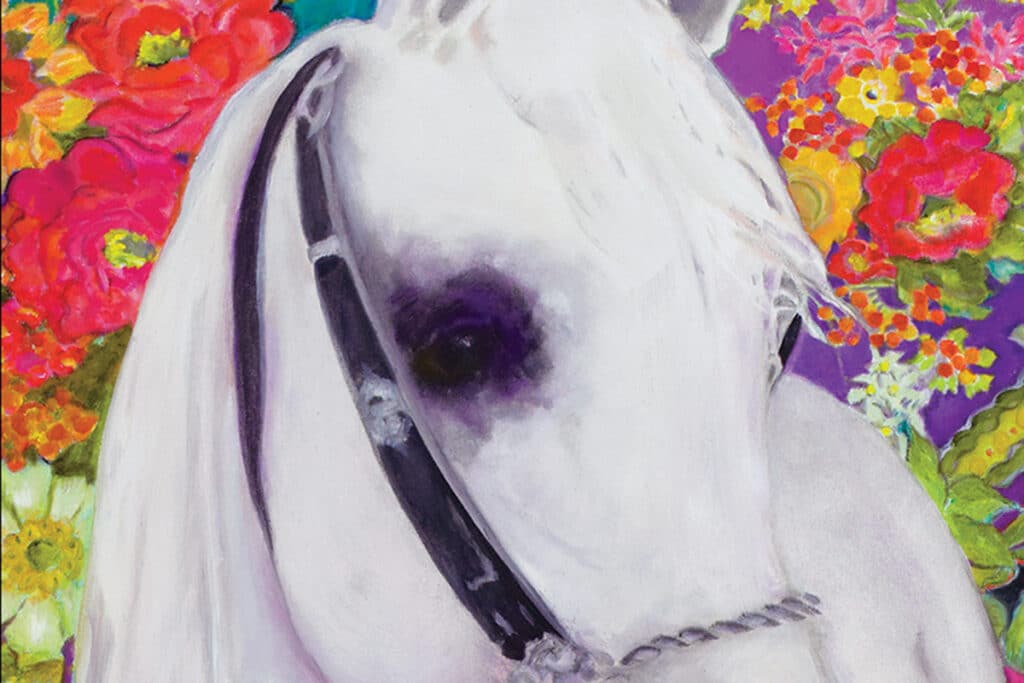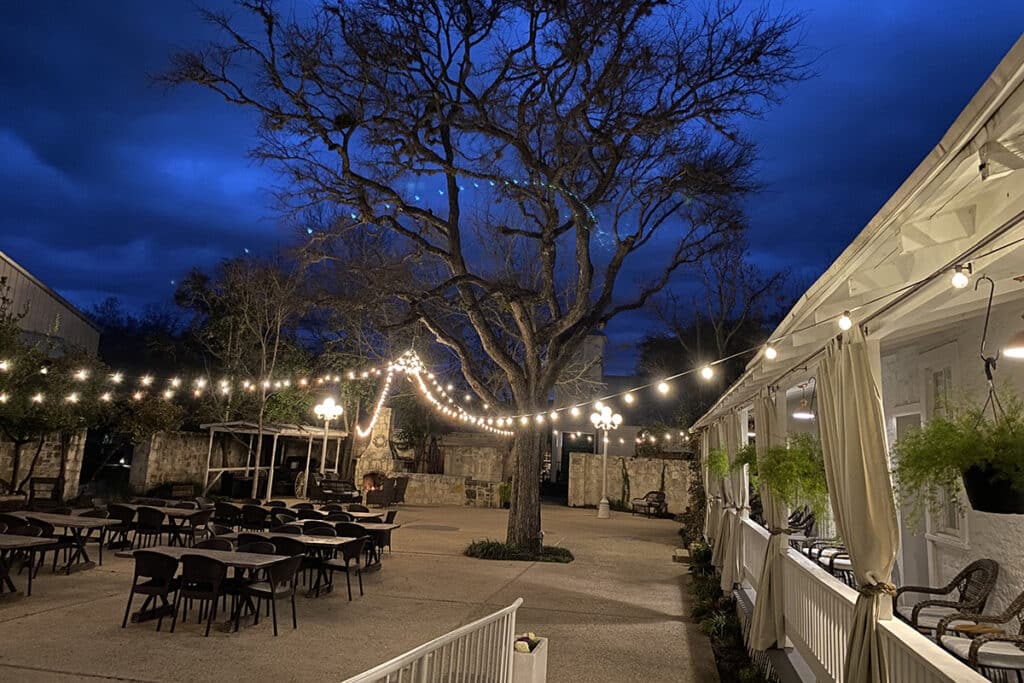Lesta Frank’s house is like a gallery for her work. From delicate flower vases reminiscent of old botanical illustrations to paintings of women with mythical implications, the rooms tell the story of her artistic interests. On an easel in the living room stands a giclee print of her Mother Divine, showing a hazel-eyed young woman gazing out serenely with a somewhat ambiguous expression, her head adorned with a riotous crown of feathers. The reason Frank is displaying the print is because the original has already been sold. “It started with Mother Mary inspired by a statue I saw,” explains the artist, standing by the easel, “but it later changed. She (the painted figure) was supposed to have a glowing halo around her head, but it so happened that I started blowing on the paint, and I went ‘Oh! It looks like feathers.’ So, I liked that and developed it further. The person who bought it put it on an altar, and she meditates in front of it.”
A few yards away, in the dining room, there’s another example of mythical creatures titled Mystical Muses, depicting two standing women who bring to mind ancient Egyptian figures. Yet Frank’s models were mannequins from a shop window. Cleverly, through her composition and pale watercolors, she imparted to these plastic dolls with vacant stares a sense of transcendental mystery. To enhance the effect, the artist “framed” the central image with a floral border. That last part wasn’t originally planned. But as she was looking at her photos of the mannequins, one of the photos accidentally fell on a much larger photograph of roses. That sparked a new idea: The roses would make a perfect border for her muses. “You have to take advantage of such moments of serendipity in the art-making process,” she says. Other paintings in the series have titles such as Moon Goddess, Sea Fairy and Presencia Infinita. But Frank is also known for her still lifes, colorful florals and figurative paintings of ordinary people. At the time of this writing, the artist was planning to exhibit some of her work at Temple Beth-El’s Artastic! fund-raising event in October and later in November at the Gallery (office) Building (1901 Military Highway), where she will have a solo show. Otherwise she rarely participates in exhibitions and has no gallery representation.
It was different in the past, she explains, but she has not found a good match with any particular gallery lately. Word-of-mouth and a Web site are her ways of reaching the public. “I do a lot of architectural illustrations and house portraits for Realtors, so I meet a lot of people and then other people through them,” she notes. “A good portion of my work is done on commission.” Besides the two types already mentioned, she also paints murals as well as portraits of pets, wedding parties, family groups and individuals. In addition, nonprofit organizations sometimes contact her to do their posters, invitation cards and/or watercolors for auctioning during their fund-raising galas. In December, for instance, invitations to this year’s Poinsettia Ball, organized by Friends of Hospice San Antonio, bear her design, while two of her original poinsettia paintings will be auctioned off during the Dec. 10 event. Unlike many of her colleagues, Frank is comfortable working on commission: “Ideally, it would be nice to just do what I want to do and have people buy it, but over time I have grown to enjoy (commissioned work). There’s a synergy there between me and the other person. We both start with ideas, and we develop them together. It’s a challenge to stay true to both our visions. Of course, I wouldn’t want to be completely commercial.”
The mythical/mystical women series is definitely something she is doing for her own soul, as were other series in years past, such as paintings inspired by the female trick rodeo riders of the 1920s and ‘30s and a body of work focusing on tropical fish. For both of those, Frank employed a two-step approach to creating the final images. She first assembled a photo collage of various elements pertaining to her concept of the image, then painted the actual image to look like the collage. Moving the collage elements around “was a great way to invite surprise into the composition,” notes the artist. Today, the large tropical fish paintings belong to the Marina Hotel at St. John’s Place in Jacksonville, Fla., while other pieces hang in the corporate collections of MasterCard in New York, the Palacio del Rio Hilton and the Marriott Rivercenter Hotels in San Antonio, the Bexar County Justice Center and in a few other places. A couple of prominent San Antonians have also bought her paintings. Along the way, she has won a few awards, starting with the 1971 San Antonio Art League prize, and more recent recognition, such as the 2007 Texas Watercolor Society Camellia Artists’ Materials Award and a 2009 merit award at the San Antonio Watercolor Group juried show.
Art and a spiritual quest
A native of the Alamo City, Frank has been interested in art since childhood. In high school she was voted best artist of her senior class and later went on to study art, first at UT Austin, and subsequently at the Cranbrook Academy of Art in Michigan, where she pursued print making. A master’s degree from the Rochester Institute of Technology followed a couple of years later. Along the way, she also got married despite an oblique warning delivered via a fortune cookie. With laughter, she recalls cracking open a cookie one day before the wedding to read the following: “You’ll always be more successful if you remain frank.” At the time she interpreted the message to mean she should keep her maiden name, Frank, but in retrospect, she says, it was prophetic. The marriage dissolved in five years. Following a brief period living close to nature in New Mexico, the artist resettled in her hometown for good. She has been single ever since and has no children.
“I don’t think it was meant for me to have children in this lifetime,” she observes. “My focus has been on my art. I love children, so maybe next time.”
This is not just a casual statement. Though emotionally attached to her Jewish roots, like many contemporary Americans, Frank has explored other spiritual paths, including the teachings of Scientology, which encompass belief in past lives. “It opened a new world for me,” she says. “Not that I would advise anyone to take up Scientology. There’s too much crazy energy about it these days.”
But for her, learning how to get in touch with her former selves was meaningful. The technique used is to try to remember a certain experience going further and further into the past. Before you know it, says Frank, you have slipped into a past life. In that state, you are no longer your present self, but you know it’s you. Though she no longer engages in that exercise, sometimes a bit from a former life will pop into her awareness and help her explain something she is dealing with at present. “What past lives have done for me is help me understand karma,” she says. “I understand better myself, relationships and the meaning of life.” Other spiritual modalities that have attracted her attention over time are Buddhism and its offshoot Zen, sacred geometry and healing practices. On her coffee table is a shambhala (a Buddhist contemplative practice) healing tool, which looks like a small metal sculpture with pieces of paper inserted into the metal loops. The papers bear names of people needing healing. Frank explains that you hold it on your lap while you pray for healing. Zen meditation is still a regular part of her daily routine. Given the importance of spirituality in her life, it was only natural for this interest to influence her art. For instance, in her 20s she used her work as a form of therapy, working out her problems through her paintings. “My art was more disturbing,” she recalls. Today her goal is to convey feelings of joy and peace.
On the technical front, Frank has expanded to embrace a variety of media beyond watercolors, experimenting with gouache, watercolor crayons, textured borders and stamps. And her newest paintings incorporate abstract touches that enrich her images. “You get bored with what you are doing, and you want to branch out into something more challenging,” says the artist, who, in person, comes across as pleasantly low-key and unpretentious. “I am not jumping off the cliff by suddenly turning into an abstract artist, but I am including more texture, mixed media and more abstract elements in my work.” Then, pausing to reflect for a moment, she adds: “I just want the energy of my paintings to have a healing effect on people, to uplift them.”
Author:
Jasmina Wellinghoff




